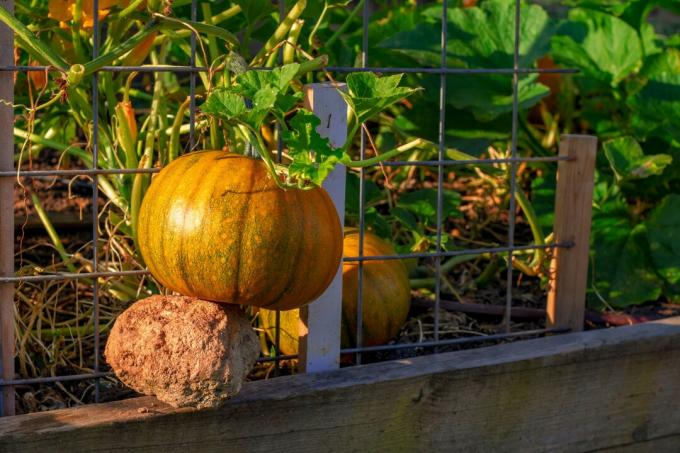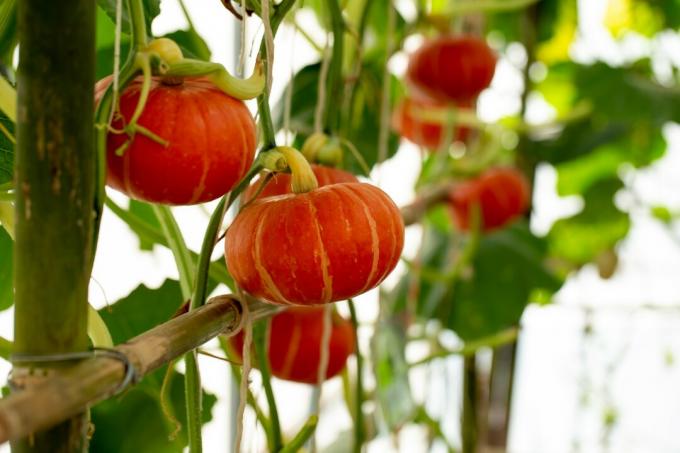Pumpkin trellises are not difficult to build and bring benefits to growing. In addition, it looks nice to let the pumpkins climb on it.

pumpkins (Cucurbita) are easy-care plants that usually take up the entire garden without much effort and bring a rich harvest. If you don't have that much space or are growing decorative pumpkins, you can pull up your pumpkins and let them climb. This is how you quickly get a green, rampant hedge. We show which pumpkins need a trellis and what you need to consider when building a trellis for Hokkaido pumpkins and the like.
contents
- Which pumpkins benefit from a climbing aid?
-
Build climbing aids for pumpkins yourself
- Supports for climbing pumpkins in raised beds
- Pumpkin trellis on the balcony
Which pumpkins benefit from a climbing aid?
Climbing aids for pumpkins are very useful and practical in some cases. They bring the following advantages:
- The extension is space-saving. Trellises help pumpkins on the balcony, for example, to make full use of the vertical space.
- The fruits do not lie on the ground and therefore do not begin to rot so quickly.
- Leaves and pumpkins are less accessible for snails and voles.
- The plants dry off better, so that fungal diseases occur less quickly.
- They can act as shade donors.
- An east-west orientation allows better use of light, which benefits the heat-loving plants.

Nevertheless, a climbing aid is not suitable for every pumpkin. First of all, it is only suitable for climbing pumpkin varieties, not for those with bushy growth. In addition, a trellis should only be used for pumpkins with small fruits. For example with extra small Hokkaido sorts and also with butternut squash climbing aids can be used without any problems. Trellises also make sense for ornamental gourds. After all, you want to see their fruits and that is not possible on the ground, hidden under leaves. A large selection of pumpkin varieties can be found in our article with one Overview of many edible pumpkins suitable for decoration.
At a glance: For which pumpkins is a climbing aid suitable?
- Climbing pumpkin varieties without bushy growth
- Pumpkins with small fruits
- ornamental gourds

Tip: Another special type of pumpkin cultivation is the South American practice of the Milpa culture. Pumpkins are grown in a bed together with corn and beans.
Build climbing aids for pumpkins yourself
You can get creative when building a trellis for pumpkins. You can usually put something together from things you already have at home or find in nature and you don't have to buy anything. The pumpkin can hold on to rather rough sticks up to finger thickness very well. The following can be used to build a pumpkin plant trellis:
- Existing fences
- Remnants of wire mesh or bar grid fence
- wire mesh
- Sticks of bamboo, hazelnut, willow or other branches
- tension wire
- Dead trees, provided they are still stable

Building a simple climbing aid for pumpkins yourself is not difficult and can be done in just a few steps.
Material:
- At least 2 support posts
- An old piece of chain link fence, bamboo or hazelnut sticks, tree mats, etc.
- String, zip ties, or U-nails (cramps)
- Folding ruler and possibly a spade, spirit level and a large-faced hammer
- Possibly scissors, side cutters, pliers or a hammer

Proceed:
- Dig holes for the support posts 1 to 1.2 meters apart. They should be at least 1/3 the depth of the posts. Dig a little deeper, and in heavy, clayey soil, fill the hole with gravel, sand, or rocks to increase the durability of the wooden stakes.
tip: When using, for example, mild steel, it is important that all posts line up exactly. Therefore, start with the end posts: A cord is stretched between them, which the middle posts are based on. - The support posts are placed in the holes and some earth is filled in, which is trampled down.
- The posts are aligned vertically using a spirit level.
- Now the holes can be completely filled with substrate and the posts driven in deeper, for example with a sledgehammer.
- Finally, the earth around the support posts is firmly compacted.
Tip: For a faster, but also less stable and permanent variant, simply drive pointed posts directly into the ground. This is easier when the soil is slightly moist. - Fasten the piece of chicken wire, old garden fence, welded mesh, or stakes vertically to the support posts with heavy-duty twine, zip ties, or U-nails. The orientation of the bars can be vertical or horizontal, depending on where the trellis is attached and how heavy the expected fruits of the pumpkin are.
Of course there are no limits to the construction of climbing aids and these simple instructions can be individually adapted and modified. A pumpkin trellis or a sunshade with longer support posts can also be built according to these instructions. Here the posts are not just driven into the ground in a row, but for example in a square or in a circle. A kind of grid made of hazelnut sticks, for example, is also attached as a roof. The only problem with using it as a sunscreen is that you are still sitting under a bare trellis during the spring. Only when the pumpkin has grown sufficiently will shade slowly appear.

Supports for climbing pumpkins in raised beds
You can proceed in a similar way when building climbing aids for pumpkins in raised beds. Here, however, the support posts should be a little shorter. If, for example, welded wire mesh is used, it can also work to bury it directly in the ground without posts. Furthermore, with raised beds, the frame can serve as an anchor for the posts, so that they do not have to be buried.

tip: You can decide where to grow the pumpkin. For example, if it initially grows away from the trellis, you can simply move the shoots around as it suits you. Once he has started to climb, there is no longer any need to tie up the pumpkins or anything similar.
Pumpkin trellis on the balcony
Hazelnut rods can also be easily used to make climbing aids for pumpkins in pots on the balcony. To do this, three to four rods are placed in a circle on the outside of the pot. The hazelnut rods are bent together at the top and tied with a string to form a kind of pyramid. Now you can either stretch strings across it in a circle or “weave” very flexible hazelnut or willow shoots around the vertical sticks. Your little climbing aid for pumpkins on the balcony is ready.

Whether with or without trellis - there are a few things to consider for a rich pumpkin harvest. Therefore, we have everything important in a separate article Caring for and harvesting pumpkins clearly summarized.
